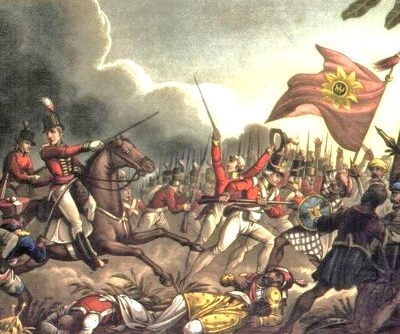The purpose of this
article is –
- To know the pre-history of Plassey
- To know the contemporary history of ‘The Battle of Plassey’
- To know the impact of ‘The Battle of Plassey’
About Battle
- Date: 23 June 1757
- Fought between the Nawab of Bengal and the British East India Company
- Location: Palashi, on the banks of Bhagirathi river near Calcutta
- Result: Decisive victory for the British East India Company
- Territorial Changes: Bengal annexed by the East India Company
Causes of the Battle of
Plassey
- The rampant misuse of the trade privileges given to the British by the Nawab of Bengal
- Non-payment of tax and duty by the workers of the British East India Company
- Fortification of Calcutta by the British without the Nawab’s permission
- Misleading Nawab on various fronts by British
- An asylum was provided to Nawab’s enemy Krishna Das
Belligerents
|
Nawab
Siraj-ud-Daulah |
The East India Company |
|
|
Commanders and Leaders
|
Nawab
Siraj-ud-Daulah |
The East India Company |
|
Nawab Siraj-ud-Daulah
|
Colonel Robert Clive
|
Strength
|
Nawab
Siraj-ud-Daulah |
The East India Company |
|
|
Casualties and Losses
|
Nawab
Siraj-ud-Daulah |
The East India Company |
|
|
Aftermath
- According to the treaty drawn between the British and Mir Jafar, the British acquired all the land within the Maratha Ditch and 600 yards (550 m) beyond it and the zamindari of all the land between Calcutta and the sea.
- The treaty also required the restitution, including donations to the navy squadron, army and committee of £ 27,50,000 to the British for their losses.
- No money or agreements were provided to Umichand, a Bengal merchant who was one of the main conspirators against Nawab in the battle.
Effects
Political Effects:
- Mir Jafar was crowned as the Nawab of Bengal
- The French were no longer a significant force in Bengal
- The British turned into the paramount European power in Bengal
Economic Effects:
- Post the victory, the British started imposing severe rules and regulations on the inhabitants of Bengal in the name of tax collection.
- The economy of Bengal was affected severely while the tax and wealth earned from Bengal helped the British to balance all of their trade liabilities.
- By ousting the French from Bengal, the British got complete control of the Trade ports in Bengal. This region then became the treasury of the British.
Conclusion
- The direct result of the Battle of Plassey is the political growth of the East India Company and the political establishment of the British Empire in the state of Bengal.
- The East India Company through the puppet government of Mir Jafar acquired Bengal’s trade and commercial control.
- The Battle of Plassey is considered the start of British rule in India.

